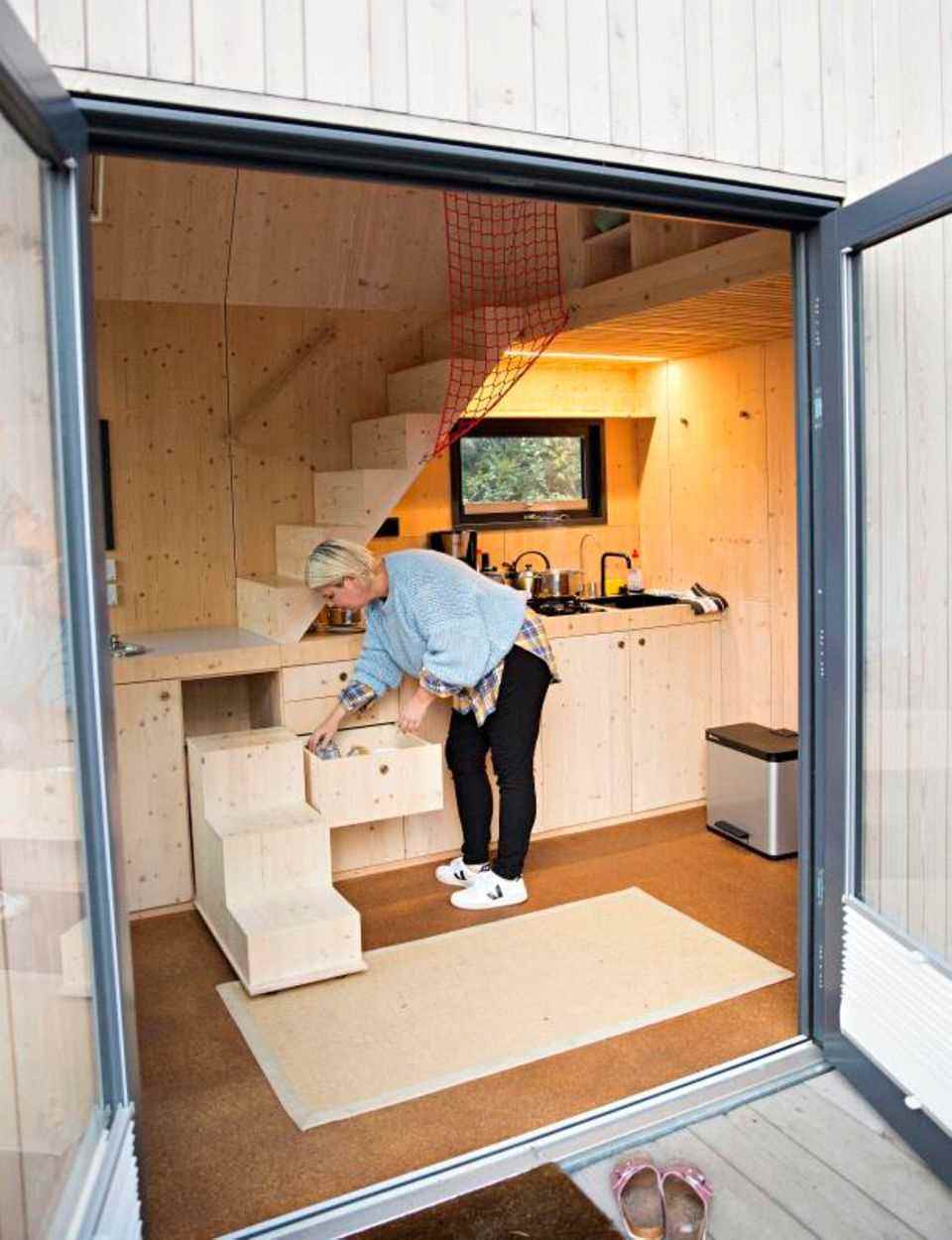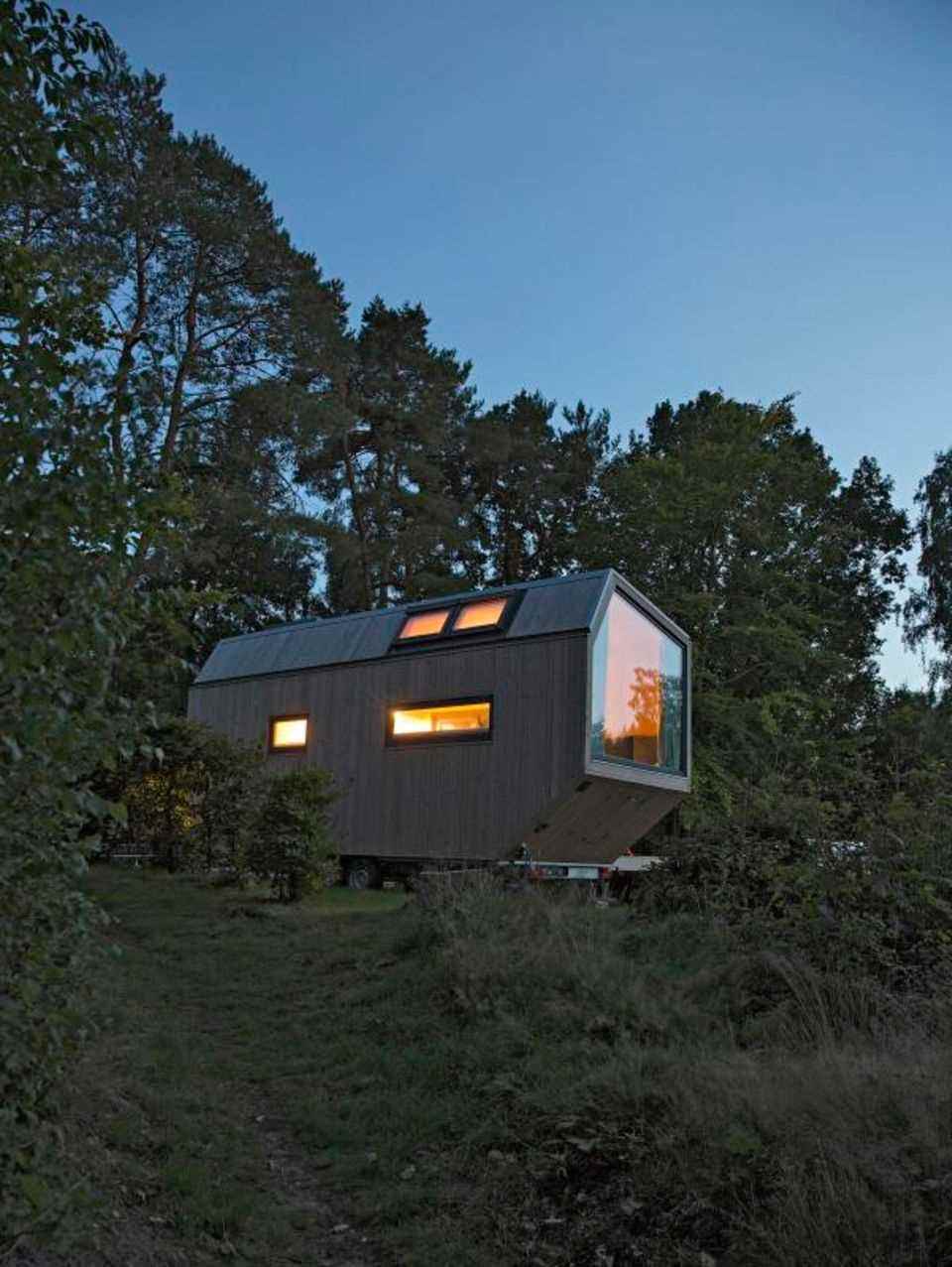How much space does happiness need? Verena Lugert has been dreaming of a small house in nature for a long time. She did the reality check in a tiny house in Schleswig-Holstein.
“The little house under the trees by the lake”: This is how a poem by Bert Brecht begins that I always liked very much. A mini poem – it has just 21 words. It comes to mind when Kathrin, the photographer, and I see our tiny house for the first time, this wooden cube, our home for the next few days. It stands under trees at Lake Salem in Schleswig-Holstein. I solemnly cradle the key we have just been given in my hands. Finally!
A childhood dream comes true
I’ve wanted a tiny house for as long as I can remember. Even in kindergarten, I always hid in the doll’s playhouse, which was so small that only one child could fit in it. At home I sat under the kitchen table and dreamed that it was a house. In elementary school there were diligence pictures, my favorite showed a forest scene: A miniature house in the form of a toadstool with a smoking chimney could be seen, nestled against the mighty roots of a tree, in front of the mushroom sat a dwarf in the sun.
We are smitten: the Tiny House is a jewel
I turn the key in the lock, open the door, we hold our breath in anticipation – and are smitten: The Tiny House is a jewel, also inside made entirely of wood, which even smells like it. With a staircase that looks like a sculpture and leads to the sleeping platform under the roof. With a cast iron wood stove. With a simple, stylish kitchenette. And with a huge panoramic window that takes up the entire front and offers the best view: of the lake, of the trees, of the grass that sways gently in the wind.
I lie down on the upholstery of the lounger that spreads out in front of the huge window and look up at the blue sky, over which little clouds are drifting. I could look for hours. This place is perfect, this inside in the outside. That clarity. That feeling of isolation.
Spacious The lounge area in front of the panorama window
© Kathrin Spirk / Brigitte
A tiny house is surrounded by the magic of forest solitude, of being alone in nature. It is in him that the desire to live as simply and independently as possible is manifested.
That’s why it’s more than just a tiny property: it’s a symbol of the longing for less.
But we don’t miss comfort. On the contrary: the bathroom is stylish, almost luxurious. Sure, there’s little storage space, but we solve the problem by being disciplined about packing everything in our bags that we don’t need immediately. As a couple you have to be considerate with your belongings, but there is enough space to be. With a whole family, however, it could get crowded. The only question: where to put four towels to dry?
This was thought through!
But basically the house is wonderfully well thought out with all the trimmings. A small staircase folds out of the wall at right angles to the larger one leading to the sleeping platform; Plants filter the air in the room; the duvets are made of camel hair, the sheets are made of organic cotton, and the building is insulated with Baltic seaweed. The astronaut shower, which is designed to save 90 percent water and 80 percent energy, is hot, the fittings are cool and dignified. The price is also solid: you pay 149 euros, which is quite a lot for one night.

Practically The staircase folds out of the kitchenette
© Kathrin Spirk / Brigitte
But worth every penny, I think to myself when I wake up on the first morning and look through the softly misted window at the world emerging from the morning mist. I watch with fascination as the trees emerge from the twilight, watch the sunrise, watch a squirrel. And lose myself in the sight of the lake, just a stone’s throw from my panoramic camp. I wrap myself in a towel and go out to the shore, into the soft water that smells of forest and peat, still cool from the night.
I wonder if I could live like this
It’s going to be wonderful days, we’re going on bike rides and sitting on our sunlit terrace, talking or being silent. And look at the lake in which we swim again and again. On the last evening we eat outside, the night is clear and starry. A candle burns, we drink wine. Then Kathrin wants to heat up the stove and I want to go to the water one last time.
I wonder if I could live like this. In so little space. And wouldn’t I feel lonely? I walk slowly back to the house, which glows like a lantern in the darkness – and a fire is burning in the oven now, puffs of smoke rise from the chimney.

© Kathrin Spirk / Brigitte
And then the rest of the Brecht poem comes to mind:
The little house under trees by the lake
Smoke rises from the roof
he was missing
How bleak then
would be house, trees and lake
So could I live like this? No, I know at once. But for a break, a small house under the trees by the lake is the most beautiful thing I can have.
Verena’s travel tips for a break in a Tiny House at Lake Salem
SPEND THE NIGHT
Green Tiny House on Lake Salem. The cottage, built according to ecological standards, is a design dream that accommodates up to four people. It has a shower room, kitchen, oven and porch and is part of the “Salemer See” nature campsite. From 145 euros/night (Salem, Seestr. 60, Tel. 045 41/825 54, greentinyhouses.com, camping-salem.de).
ENJOY
wildthroat. The campsite at Lake Salemer has a nice restaurant with a beer garden. There are delicious dishes on the menu: wild boar sausage in a bun for around 4 euros, vegan pizza for around 10 euros or baked zander for around 15 euros (Salem, Seestr. 60, Tel. 01 70/446 14 03).
imperial court. A few minutes by bike away, in the middle of meadows and pastures. The farm shop sells jam, sausage and cheese, as well as fresh bread rolls. Or you can stay for breakfast in the courtyard café (from about 7 euros with a drink). You should definitely stop by for coffee and cake, butter cake 3 euros, cake around 4 euros (Salem, Seestr. 58, Tel. 045 41/84 04 41, hofkaiser.de).
EXPERIENCE
Grenzhus Schlagsdorf. During the Cold War, the border between Eastern and Western Europe also ran right through the Schalsee, the “Grenzhus Schlagsdorf” on the former death strip is a memorial and an excellently designed museum on German-German history. Admission 4 euros (Schlagsdorf, Neubauernweg 1, Tel. 03 88 75/203 26, Grenzhus.de).
